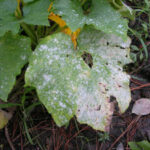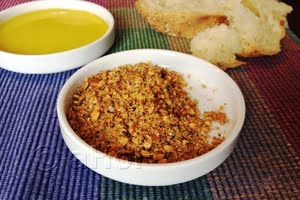Problems with powdery mildew in your garden? You are not alone; many professional gardeners along with those who dabble in the art of gardening have had this problem for years. Researchers over in Europe have found a solution though to your powdery mildew blues.
Powdery mildew is a common disease in vegetables and on grass in a lot of gardens around the world; it is not just in America. It can occur on just about any vegetable or even some fruits such as okra, beans, watermelons, honeydew, pumpkins and so on. Although powdery mildew resembles a light dusting of flour on top of the leaves of the vegetable plant, it is actually caused by a fungus that is airborne. When plants are first infected, the leaves will show small, round, and lightly whitened spots against the green or yellow background. The spots always remind me of the spots on a freshly cleaned automobile that has not been dried properly. As the disease escalades, the spots grow in size and soon resemble the light dusting of flour that is most notable of this disease. If the leaf was placed under a microscope though, the flour would appear to be a bunch of tiny spores crammed into one small location. These spores are easily caught up in the wind and blown around the yard or even neighborhood.
It is important to catch up with this disease before it overtakes the plant that has been infected. Plants that are heavily infected will showcase brown or even black spots on the leaves and vegetable or fruit that it produces. If you have ever seen a black spot on a green bean, it is most likely the case that it is fungus. If the disease is not fought, then the entire plant will be infected and nothing can be eaten safely from the plant. In addition, the fungus disease will increase and infect other plants in your garden and others around your garden. Severe economic damage can occur if you are planning on selling your produce.
The normal reaction to a powdery mildew infected plant was to snap off all the foliage that was infected and keep a good eye on the plant. The hard part about this fungus disease is that it is alive during all weather conditions. It is able to grow slowly in dry conditions and flourishes in wet conditions. In addition, the only fungicides on the market today to work against this disease work only work to prevent the disease not get rid of it. There were some gardeners that used baking soda spray however it is sticking and can cause the plant to have a strange taste. There is no getting around the disease.
Until today that is, there has been no cure to powdery mildew. Wagner Bettiol, a scientist in Brazil found that using milk will actually control this powdery mildew. Yes, normal milk will actually control powdery mildew and contains a natural foliar fertilizer, boosting the plant’s immune system in the process. Bettiol found that a mixture of at least 10% milk mixed with 90% water will significantly reduce the severity of powdery mildew when sprayed weekly on the plant. Scientists are still baffled as to why this powdery mildew is actually cured from just using milk. Some believe it might just be to the fact that most milk contains natural salts and amino acids that acts like a natural germicide. New Zealand also found out about this new cure and has started to see changes on the grapes that are used for wine production.
It is amazing that this simple natural ingredient will cure powdery mildew when chemical sprays were not as effective. It is great to hear that there is a natural cure, especially since the produce is grown to eat and drink. Organic gardeners such as me are thrilled! Basically, any kind of milk can be used, even skim milk. It is a green cure and inexpensive, how could that be any better!





